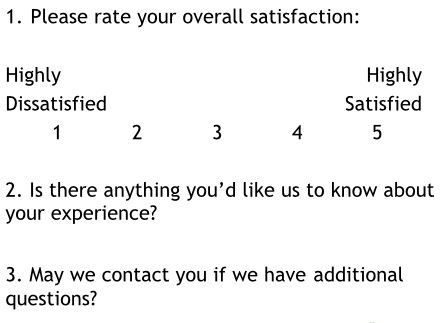Note: This post originally appeared on the Salesforce blog. Check out my latest post on the Salesforce blog, "Why Role Playing Doesn't Work for Customer Service Training."
Customers are getting tired of surveys. A 2010 study by Vovici revealed that Americans are inundated with over 7 billion survey requests per year. That’s nearly 23 survey requests for every American. (Ironically, I encountered a pop-up survey request when I went to the US Census Bureau website to track down that statistic.)
Many companies survey their customers, but that doesn’t mean they are doing it right. Here are five signs that a customer service survey program is missing the point.
1) Your survey has no purpose
Perhaps someone in customer service decided a survey was a good idea so they wrote a few questions. Then marketing added a few more questions. Sales chimed in with a few questions of their own. Operations got in the act too. The end result is a 100-question survey with no clear purpose.
Thinking of questions to ask your customers is the wrong place to start. Instead, think about what you specifically want to know and then design your survey to achieve that clear purpose.
Keep in mind that you may have multiple audiences. For instance, a business-to-business software company might have a transaction survey for users contacting technical support and a relationship survey for executives who make buying decisions.
2) Your survey is tiresome
The second sign of a pointless survey is it needlessly annoys customers.
For example, the dealership where I get my car serviced routinely sends me a 36 question survey after I get an oil change. That’s obnoxious.
Focus on what you really want to know and limit your questions to as few as possible. You can always use text boxes to capture additional information.
My car dealership could cut their survey from 36 questions down to 3 and still get an amazing amount of useful data:
- How satisfied were you with your recent service?
- (Comment box): Is there anything we can do better?
- Would you like one of our service advisors to follow-up with you?
Correlating satisfaction levels with individual comments could tell the dealership what they’re doing well and what can be improved. And, asking customers if they’d like to be contacted allows service advisors to try to fix any problems that customers are venting about.
3) You’re focused on the score, not the feedback
The third sign a survey is missing the point is focusing on the score and not the feedback.
The service department at my local dealership provides a great example. All of their post-transaction follow-up focuses on cajoling me into giving them a good score on their survey. My actual feedback is irrelevant.
- A sign by the cash register reminds customers they’ll be getting a survey.
- Someone from the dealership calls the next day with a reminder about the survey.
- The service advisor sends an email reminder a day later.
Each point of contact encourages customers to provide a top box score on the survey. At no time are customers asked about the quality of service they’ve received.
Surveys should be designed to give you feedback that you can use to improve service. Focusing on a score versus the feedback itself defeats that purpose.
4) You only look at aggregate data
The fourth sign of a pointless survey is the data isn’t analyzed. Only total scores are viewed.
Knowing what percentage of your customers are satisfied is a relatively useless statistic. There’s not much you can do with that.
It necessary to dig a little to make customer service survey data truly useful. For example, let’s say you have a 75 percent customer satisfaction rating. It takes a little bit of analysis to reveal actionable information:
- Is service quality consistent amongst all employees?
- What factors make it more likely for a customer to be satisfied?
- What factors make it more likely for a customer to be dissatisfied?
5) You Don’t Take Any Action
The last sign of a pointless survey is the company doesn’t do anything with the data it collects.
Chip Bell, author of 9 1/2 Principles of Innovative Service, shared this startling statistic with me:
95 percent of companies survey their customers but only 10 percent actually use the feedback to take action.
It’s a waste of your customers’ time to ask them for feedback and then do nothing with it. It’s also a waste of your time too.
Smart companies use surveys as part of their continuous improvement cycle. They analyze their survey data to look for trends and pinpoint problems. This analysis leads to solutions that are implemented to improve service. Creating survey’s that generate actionable results is the key to creating a company that is constantly evolving and improving.
Want to know more?
Here are links to recordings of two of my recent webinars on making the most of customer service surveys:



















